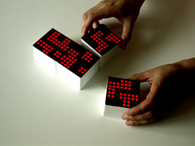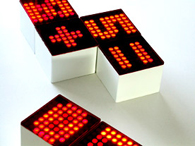Creative Lab: TileToy - A
Modular Electronic Game Prototype
Led by Tuomo Tammenpää & Daniel Blackburn
Fee: £20
To join this workshop please contact Clare Danek on:
+44(0)870 990 5007
or email info@ultrasound.ws
for further information.
Who For
The workshop is designed for artists, designers and students
interested in physical computing, computer programming and game
design. Experience in soldering, Max/MSP or PicBasic / Basic stamp
programming will be useful but not essential.
Introduction
TileToy is a modular, electronic game prototype for tangible
LED game tiles. TileToy brings the flexibility inherent in software
to a physical tile that people can touch and interact with. By arranging
multiple tiles, players can engage in various kinds of game play,
from fast-paced arcade style games to puzzle games or learning games.
Compared to traditional tile games, this TileToy can avail itself
of changing-state strategies, animations and games where the tiles
can affect the state of adjoining tiles. TileToy can also be used
to display information or used for purely aesthetic purposes.
The tiles are plastic cases approximately 2" square. The main
inspiration for the look and feel comes from the heyday of the LED,
when plastic hand-held games ruled the gaming world. This retro-look
is fused with a more modern minimal design. The minimalism enhances
the magic of cordless boxes that simply communicate with each other.
In TileToy, technology is sealed within the design. The interaction
is based on tactile experience where no user manual is needed.
The re-programmable and constantly updated graphical
information on each tile is displayed with a LED matrix system.
The screen displaying the information is an endlessly versatile
surface for updated visual communication. Each tile is controlled
individually and can be used to transmit information on its own
or in groups of several tiles. The assembled tiles transmit wirelessly
their individual position in relation to each other and based on
that changing information, a central computer, or a dedicated tile
runs the different applications.

Open software and hardware project
TileToy is an Open project. Both the source code and the hardware
will be made available via open licenses. The aim of TileToy is
not just to create something that we ourselves can use to create
interesting games and demos for, but as a platform that anyone can
use to create unique content. Making the software open will allow
people to create their own applications and games and feed these
back into the community hopefully to spark further innovation. The
open hardware will also allow people to make their own TileToys
cheaply without paying a third party. It may even lead to new projects
that branch off to make new versions of TileToy based on the original
hardware.
Open source software
The initial PicBasic code used to control the tiles will be released
under the GPL or LGPL (see http://www.opensource.org
for more details) by the end of November 2005. The code will most
likely be released via sourceforge but details will be posted via
http://tiletoy.blogspot.com.
After the initial release of the Pic based code we will then look
to open up the code to other alternative platforms we have experimented
with, such as java code and Max/MSP code. There is no fixed timescale
for this yet.
Open source hardware
The first open hardware version will be a list of components needed,
first circuit design schematics and brief instructions for DIY tiles.
At this stage, the main objective is to initiate the development
for simpler and cheaper version of TileToy with people who are more
experienced in electronic design and engineering. Open hardware
will be released by the end of November 2005 via http://tiletoy.blogspot.com
TileToy Ultrasound Workshop
Workshop schedule:
DAY 1.
morning: Introduction
- TileToy introduction, process, future
- TileToy presentation, playing some games
- planning the workshop - skills check: groups, pairs,
individuals
afternoon: Soldering
- equipment & parts check
- preparations, cutting boards
- soldering pic, programming & power components
- checking, debugging first components
DAY 2.
morning: Soldering
- status check
- soldering radio and
- testing, programming
afternoon: Soldering & debugging
- soldering reed switches
- glueing magnets
- testing & debugging
DAY 3.
morning:
- status check
- introduction to programming TileToy: PicBasic & Max/MSP
- explaining PicBasic client code & possibilities for
game programming
- explaining serial radio communication with Max/MSP patch
afternoon:
- coding / patching a simple game
- testing games, results
- where from here -discussion
Aims
The aim of the workshop is to give an insight and hands-on experience
into the many processes used in creating a project of Tiletoy’s
complexity. By the end of the workshop the participants should be
able to make more tiles and create new applications on their own.
Participants will also gain general experience of working with Pic
micro controllers and basic electronics.
www.tiletoy.blogspot.com
top |


